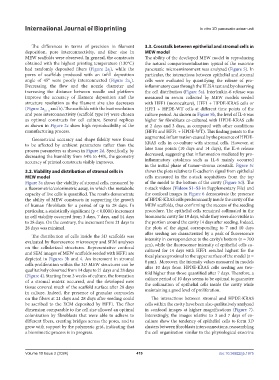Page 427 - IJB-10-2
P. 427
International Journal of Bioprinting In vitro 3D pancreatic acinar unit
The differences in terms of precision in filament 3.3. Crosstalk between epithelial and stromal cells in
deposition, pore interconnectivity, and fiber size in MEW model
MEW scaffolds were observed. In general, the constructs The ability of the developed MEW model in reproducing
obtained with the highest printing temperature (130°C) the natural compartmentalization typical of the exocrine
had randomly deposited fibers (Figure 2a ), while the pancreatic microenvironment was analyzed (Figure 5). In
i
pores of scaffolds produced with an infill deposition particular, the interactions between epithelial and stromal
angle of 45° were poorly interconnected (Figure 2a ). cells were evaluated by quantifying the release of pro-
ii
Decreasing the flow and the nozzle diameter and inflammatory cues through the ELISA test and by observing
increasing the distance between needle and platform the cell distribution (Figure 5a). Interleukin-6 release was
improve the accuracy of filament deposition and the measured in serum collected by MEW models seeded
structure resolution as the filament size also decreases with HFF1 (monoculture), HFF1 + HPDE-KRAS cells or
(Figure 2a iii–iv and b). The scaffolds with the best resolution HFF1 + HPDE-WT cells at different time points of the
and pore interconnectivity (scaffold type iv) were chosen culture period. As shown in Figure 5b, the level of IL-6 was
as optimal constructs for cell culture. Several replicas higher for fibroblasts co-cultured with HPDE-KRAS cells
as shown in Figure 2c show high reproducibility of the at 2 days and 3 days, as compared with other conditions
manufacturing process. (HFF1 and HFF1 + HPDE-WT). This finding points to the
Geometrical accuracy and shape fidelity were found augmented inflammation caused by the presence of HPDE-
to be affected by ambient parameters rather than the KRAS cells in co-culture with stromal cells. However, at
process parameters as shown in Figure 2d. Specifically, by later time points (10 days and 14 days), the IL-6 release
decreasing the humidity from 54% to 44%, the geometry decreased, suggesting that inflammation mediated by pro-
accuracy of printed constructs visibly improves. inflammatory cytokines such as IL-6 mainly occurred
in the initial phase of tumor–stroma crosstalk. Figure 5c
3.2. Viability and distribution of stromal cells in shows the plots relative to E-cadherin signal from epithelial
MEW model cells measured in the z-stack acquisitions from the top
Figure 3a shows the viability of stromal cells, measured by of the model to the bottom of the cavity (Figure 5d). The
a fluorometric/colorimetric assay, in which the metabolic z-stack videos (Videos S1–S3 in Supplementary File) and
capacity of live cells is quantified. The results demonstrate the confocal images in Figure 6 demonstrate the presence
the ability of MEW constructs in supporting the growth of HPDE-KRAS cells predominantly inside the cavity of the
of human fibroblasts for a period of up to 28 days. In MEW scaffolds, thus confirming the success of the seeding
particular, a statistically significant (p < 0.0001) increment procedure. The epithelial cells remained collimated in the
in cell viability occurred from 3 days, 7 days, and 14 days biomimetic cavity for 10 days, while they were also visible in
to 28 days. On the contrary, the increment from 21 days to the portion around the cavity 14 days after seeding. Indeed,
28 days was minimal. the plots of the signal corresponding to 7 and 10 days
after seeding are characterized by a peak of fluorescence
The distribution of cells inside the 3D scaffolds was
evaluated by fluorescence microscopy and SEM analyses intensity in correspondence to the cavity’s bottom (z ≈ 700
µm), while the fluorescence intensity of epithelial cells co-
on the cellularized structures. Representative confocal cultured for 14 days with HFF1 resulted highest for the
and SEM images of MEW scaffolds seeded with HFF1 are
depicted in Figures 3b and 4. An increment in stromal focal planes proximal to the upper surface of the model (z =
cells proliferation within the 3D MEW structures can be 0 µm). Moreover, the intensity values measured in models
qualitatively observed from 14 days to 21 days and 28 days after 10 days from HPDE-KRAS cells seeding are two-
(Figure 4). Starting from 3 weeks of culture, the formation fold higher than those quantified after 7 days. Therefore, a
of a stromal matrix occurred, and the developed new culture period of 10 days seems to be optimal to guarantee
tissue covered much of the scaffold surface after 28 days the collimation of epithelial cells inside the cavity while
in culture. Indeed, the presence of granular corpuscles maintaining a good level of proliferation.
on the fibers at 21 days and 28 days after seeding could The interactions between stromal and HPDE-KRAS
be ascribed to the ECM deposited by HFF1. The fiber cells within the cavity have been also qualitatively analyzed
dimension comparable to the cell size allowed an optimal in confocal images at higher magnifications (Figure 7).
colonization by fibroblasts that were able to adhere to Interestingly, the images relative to 3 and 7 days of co-
different fibers, creating bridges across the pores, and to culture show the tendency of epithelial cells to form 3D
grow with support by the polymeric grid, indicating that clusters between fibroblasts interconnections, reassembling
a biomimetic process is in progress. the cell organization similar to the physiological exocrine
Volume 10 Issue 2 (2024) 419 doi: 10.36922/ijb.1975

